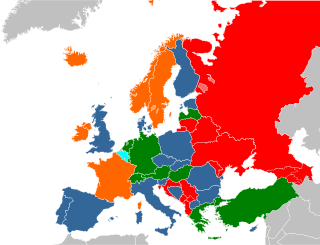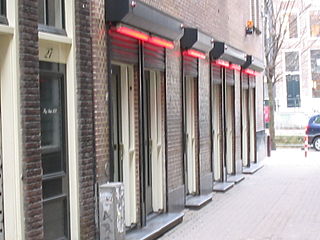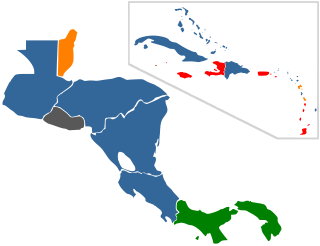Related Research Articles

Prostitution in Germany is legal, as are other aspects of the sex industry, including brothels, advertisement, and job offers through HR companies. Full-service sex work is widespread and regulated by the German government, which levies taxes on it. In 2016, the government adopted a new law, the Prostitutes Protection Act, in an effort to improve the legal situation of sex workers, while also now enacting a legal requirement for registration of prostitution activity and banning prostitution which involves no use of condoms. The social stigmatization of sex work persists and many workers continue to lead a double life. Human rights organizations consider the resulting common exploitation of women from East Germany to be the main problem associated with the profession.
Prostitution in Austria is legal and regulated.
Prostitution in Greece is legal at the age of 18, and regulated. It is estimated that fewer than 1,000 women are legally employed as prostitutes and approximately 20,000 women, half of whom are of foreign origin and the other half are Greek, are engaged in illegal prostitution. Many women affected by the economic crisis have turned to prostitution through poverty.
Prostitution in Peru is legal and regulated. UNAIDS estimate there to be 67,000 prostitutes in the country.
Prostitution in Senegal is legal and regulated. Senegal has the distinction of being one of the few countries in Africa to legalize prostitution, and the only one to legally regulate it. The only condition that it is done discreetly. Prostitution was first legalised in 1966. UNAIDS estimate that there are over 20,000 prostitutes in the country. The average age for a sex worker in Senegal is 28 years old and female.
Prostitution in Argentina is legal under Federal law. Article 19 of the constitution states: "The private actions of people that do not offend in any way the public order and morality, nor damage a third person, are only reserved to God, and are exempt from the authority of the magistrates." Organised prostitution is illegal. In addition, individual provinces may place further restriction on the trade. For example, in San Juan, publicly offering sex services for money is punishable by up to 20 days in jail. In 2012, newspapers were banned from carrying classified-ads offering sexual services. UNAIDS estimated there to be about 75,000 prostitutes in the country in 2016.
Prostitution in Cuba is not officially illegal; however, there is legislation against pimps, sexual exploitation of minors, and pornography. Sex tourism has existed in the country, both before and after the 1959 Cuban Revolution. Many Cubans do not consider the practice immoral. In Cuban slang, female prostitutes are called Jineteras, and gay male prostitutes are called Jineteros or Pingueros. The terms literally mean "jockey" or "rider", and colloquially "sexual jockey", and connotes sexual control during intercourse. The terms also have the broader meaning of "hustler", and are related to jineterismo, a range of illegal or semi-legal economic activities related to tourism in Cuba. Stereotypically a jinetera is represented as a working-class Afro-Cuban woman. Black and mixed-race prostitutes are generally preferred by foreign tourists seeking to buy sex on the island. UNAIDS estimate there are 89,000 prostitutes in the country.
Prostitution in Luxembourg is in itself legal, and is common, but activities associated with organised prostitution, such as profiting from or aiding prostitution, are illegal. Human trafficking incurs severe penalties. There are estimated to be 300 prostitutes in Luxembourg, most of whom are immigrants.
Prostitution is not illegal in Sri Lanka, however, related activities such as soliciting, procuring, and brothels are outlawed. It is also illegal to traffic persons for prostitution, especially minors. Prostitution is not as widespread in Sri Lanka as in some neighbouring countries. It is estimated that there are 40,000 prostitutes in the country, and nearly half of them operate in Colombo.
Prostitution in El Salvador is not prohibited by national law, but may be prohibited by local municipal ordinances. Municipal ordinances may also prohibit the purchase of sexual services. Related activities such as facilitating, promoting or giving incentives to a person to work as a prostitute (pimping) are illegal. The prostitution of children is also illegal. Brothel ownership, however, is legal. There are no specific laws against human trafficking, but any criminal offence that includes ‘commerce in women or children’ requires sentencing to be increased by 30%.
Prostitution in Trinidad and Tobago is legal but related activities such as brothel keeping, soliciting and pimping are illegal.

The legality of prostitution in Europe varies by country.
Prostitution in Moldova is an illegal activity but is widespread and socially acceptable. UNAIDS estimate there to be 12,000 prostitutes in the country.
Prostitution in Armenia is illegal under administrative law. Related activities such as running a brothel and pimping are prohibited by the Criminal Code, although there are known to be brothels in the capital, Yerevan, and in Gyumri. According to UNESCO, since the collapse of the Soviet Union in 1991, prostitution in the country has grown. There are about 5,600 women involved in prostitution in Armenia, roughly 1,500 of them are in Yerevan. However, official police figures are far lower, for example 240 in 2012. Police and other safety forces reportedly tolerate prostitution. Many women turn to prostitution due to unemployment.

Prostitution laws varies widely from country to country, and between jurisdictions within a country. At one extreme, prostitution or sex work is legal in some places and regarded as a profession, while at the other extreme, it is considered a severe crime punishable by death in some other places.

Window prostitution is a form of prostitution that is fairly common in the Netherlands and surrounding countries. The prostitute rents a window plus workspace off a window operator for a certain period of time, often per day or part of a day. The prostitute is also independent and recruits her own customers and also negotiates the price and the services to be provided.
Prostitution in Namibia is legal and a highly prevalent common practice. Related activities such as solicitation, procuring and being involved in the running of a brothel are illegal. A World Bank study estimated there were about 11,000 prostitutes in Namibia.
Prostitution in Kyrgyzstan has been legal since 1998, but the operation of brothels, pimping, and recruiting persons into prostitution are illegal, with penalties of up to five years There are estimated to be 7,100 sex workers in the country. Prostitution occurs on the streets, in bars, hotels and brothels.
Prostitution in Uzbekistan is illegal, but prostitution has increased within the country since the collapse of the Soviet Union. UNAIDS estimated there to be 22,000 sex workers in the country in 2019. Many of the women have turned to prostitution in Uzbekistan because of poverty.

Legality of prostitution in the Americas varies by country. Most countries only legalized prostitution, with the act of exchanging money for sexual services legal. The level of enforcement varies by country. One country, the United States, is unique as legality of prostitution is not the responsibility of the federal government, but rather state, territorial, and federal district's responsibility.
References
- 1 2 McDonald-Gibson, Charlotte (1 August 2011). "Drive-in sex plan to curb prostitutes in Europe's playground". The Independent. London.
- ↑ "Sex workers: Population size estimate - Number, 2016". www.aidsinfoonline.org. UNAIDS. Archived from the original on 4 June 2019. Retrieved 21 July 2018.
- 1 2 3 4 5 6 7 8 9 10 "Prostitution". The Swiss Coordination Unit against the Trafficking in Persons and Smuggling of Migrants KSMM. Archived from the original on 6 December 2017. Retrieved 5 December 2017.
- ↑ Jorio, Luigi (27 November 2012). "Das Recht, mit Sex Geld zu verdienen" [The right to earn money with sex]. SWI Swissinfo (in German). Retrieved 5 December 2017.
- ↑ "Der Strichplatz von Zürich Altstetten" [Sexboxes are ready]. Blick (in German). 15 August 2013. Retrieved 5 December 2017.
- ↑ "Permit tickets for street prostitutes in Zurich". EPA. Retrieved 5 December 2017.[ dead link ]
- ↑ Büchi, Christophe (31 January 2014). "egleitete Freigänge für Prostituiertenbesuch" [Accompanied free passages to prostitutes]. Neue Zürcher Zeitung (in German). Retrieved 5 December 2017.
- ↑ "Häftlinge gingen auf Freigang zu Prostituierten" [Prisoners went for free sex with prostitutes]. Tages-Anzeiger (in German). 31 January 2014. Retrieved 5 December 2017.
- ↑ "Jugendprostitution in der Schweiz: Noch kein Verbot - SWI" (in German). Swissinfo.ch. Retrieved 7 September 2015.
- ↑ "Switzerland raises legal prostitution age to 18". CBC News . Retrieved 11 September 2013.
- ↑ "SR 311.0 Schweizerisches Strafgesetzbuch vom 21. Dezember 1937". Admin.ch. Retrieved 7 September 2015.
- ↑ "CC 818.101.24 Ordinance of 13 March 2020 on Measures to Combat the Coronavirus (COVID-19) (COVID-19 Ordinance 2)". www.admin.ch. Swiss Government. 13 March 2020. Retrieved 15 April 2020.
- ↑ "Sex, in spite of the Corona-ban: Thai-love lady sentenced". www.kxan36news.com. 3 April 2020. Retrieved 15 April 2020.
- ↑ "E.U. Treaty Spurs Influx of Prostitutes to Zurich". The New York Sun . Retrieved 11 April 2012.
- ↑ "'Sex drive-in' hailed as success after year-long experiment in Zürich". The Guardian. 26 August 2014. Retrieved 2 November 2015.
- ↑ Boos, Susan (19 September 2013). "Ein Verbot schadet den Frauen" [A ban harms the women]. Woz (in German). Retrieved 5 December 2017.
- ↑ "Window ban for Zurich's prostitutes" . Retrieved 19 December 2009.
- ↑ Hunt, Julie (8 April 2008). "Red light Bern". SWI Swissinfo. Retrieved 5 December 2017.
- ↑ "Geneva : around the train station" . Retrieved 19 December 2009.
- ↑ "Red Light Districts - Switzerland". RLD-Europa. Retrieved 5 December 2017.
- ↑ "Signs lay down law and order for Basel prostitutes". The Local. 28 June 2016. Retrieved 20 June 2019.
- ↑ "Si del Cantone alla prima casa di tolleranza in Ticino" . Retrieved 7 January 2011.
- 1 2 "Switzerland 2018 Trafficking in Persons Report". U.S. Department of State. Archived from the original on 1 August 2018. Retrieved 1 August 2018.
 This article incorporates text from this source, which is in the public domain .
This article incorporates text from this source, which is in the public domain .
